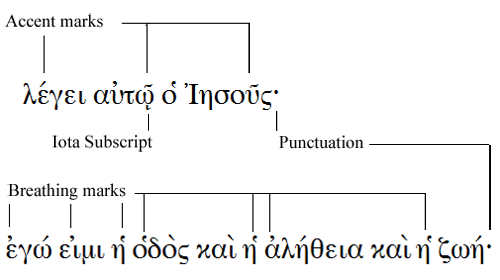As in the previous article, if you are just speaking the verses you can skip this article until you are ready to learn to read the Greek. If you are reading the Greek, you must be wondering what a lot of those marks are around the different letters in the text.
In this lesson we will look at these variations on the sounds, as when they are combined to make diphthongs, nasal gammas, iota subscripts, and have breathing marks. We will also discuss a little bit about punctuation and accents.
Diphthongs
A diphthong is the sound made when two vowels are combined to make a single sound.
Iota Subscripts
Sometimes when you’re reading you will find an iota underneath vowels, the alpha, the eta, or the omega:
These are just writing conventions, and do not change the pronunciation.
Gamma Nasals
An example is:
Breathing Marks
Notice the breathing mark above the eta:
This breathing mark, similar to an English opening single quote, adds an “h” sound to the vowel sound:
This is called a rough breathing mark
Note that there is another breathing mark, called a smooth breathing mark.
This breathing mark, similar to an English closing single quote, adds no sound to the vowel sound:
Punctuation
There are four punctuation marks in biblical Greek:
Accent marks
In English we have a single accent mark. Biblical Greek has three accents:
Accent marks are shown over vowels, and in the case of diphthongs, over the second vowel. The only thing that we are going to address here is that any syllable with an accent mark is stressed above the others.
Example
In the verse we are currently working on we see a number of examples from this lesson.
Also, there are numerous diphthongs in the above example. See if you can find them.
© copyright 2011 Mark W Smith, all rights reserved.



